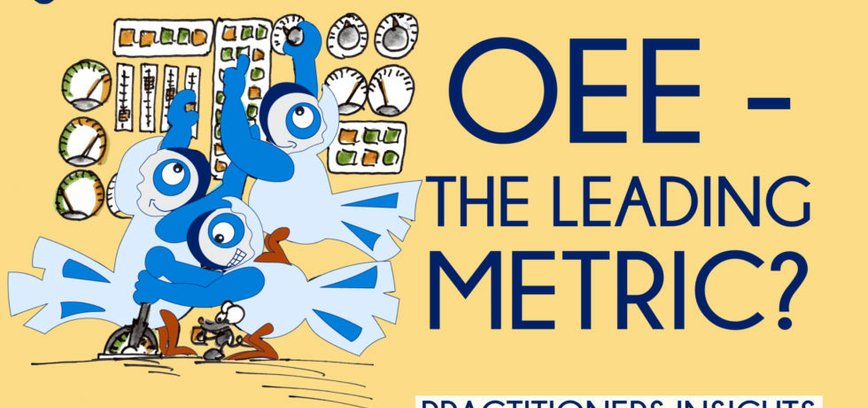An exciting discussion round on Overall Equipment Effectiveness – Open Roundtable on February 11th
Interested in basic knowledge on OEE1 and OEE2? Click here!
It’s very tempting!
OEE is a complex metric that includes many factors. OEE can depict the hourly performance per shift or per line and also the performance of the entire plant. Heads-up: What exactly do we mean by performance?
OEE only indicates how well the equipment is running, while the output of the equipment is influenced by many factors: quality problems, are materials prepared on time?, personnel planning, coordination of the supply chain, bridging of breaks, output rates, maintenance strategy, technical malfunctions, …
Yes, OEE shows a lot of a site’s performance.
Are we satisfied with the plant if OEE is high? Probably only if:
– customers can be supplied as requested,
– stocks do not overflow and
– staff costs are well balanced.
OEE does not show any of this!
OEE makes blind
If you only keep an eye on the OEE, you can lose sight of personnel efficiency, for example. It is not included in the OEE value at all, but it is an important cost factor in the plant. The system runs like clockwork, but you still might lose money, because there are perhaps twice as many people standing / running / resting at the lines.
Too much focus on OEE often means that changeovers are saved. That means bigger lots, longer campaigns and unfortunately we can’t deliver to customers because the wrong products were produced. But lots of it!
What is the goal?
Produce what it takes 24/7? The main thing is that it’s a lot? Or should the individual system be efficient when it is running? Depending on the situation, you should either work with OEE 1 or OEE 2.
OEE 1: For bottleneck equipment when you can sell everything you produce right away.
OEE 2: To make sure the equipment runs effectively when it is planned to run.
OEE – good or evil? Anything under 80% is evil?
No! Let’s take a look at two identical lines: Line 1 runs with one product, little cleaning, hardly any modifications. The other produces 20 different products in 150 variants. This production concept can be very useful. Naturally, Line 2 takes considerably more time for changeovers and cleaning. On this basis, who would seriously want to compare the two lines using OEE? It is possible that an OEE of 80% on Line 1 holds more potential for improvement than an OEE of 30% on Line 2. That depends on what actually causes the losses.
It is hardly any different looking at site OEEs. The OEE is only comparable if product mix, customer requirements, product shelf life, manufacturing costs and storage capacities are more or less similar.
Does OEE improvement always lead to cutting costs? Or to an improved service level?
If the equipment effectiveness improves and if the system produces more units per time, this can lead to cost reduction. The total cost of production can be accounted to more products, so one product is cheaper to produce.
This is true, however, only if:
– personnel costs do not rise too much at the same time,
– additional investments into maintenance, spare parts, and technology pay off,
– additional storage costs are not going through the roof and, above all,
– everything that has been produced is sold and does not have to be accounted as scrap.
And how does OEE affect the service level? At least a guaranteed improvement here?
– Is the situation such that generally more has to be produced of one product to be able to satisfy customer demands? Then improving OEE will definitely lead to improving service level.
– Or do you observe often that finished products are in stock, but not the demanded products? Improving OEE might lead to further reduction of product changeovers. In this case the service level is likely to worsen further.
OEE is a good metric for improvement management!
OEE can be used well to measure and manage improvement on the lines. Regardless of whether you start at 20% or 80%: The trend is important and shows how well you improve.
It helps to analyze each of the 3 individual factors separately: quality, system availability and output rate. That’s because these also influence each other. For example, increasing output rate can have a negative impact on output quality or lead to more short stoppages.
In combination with well-selected additional key indicators, OEE is great for further developing the plant in a target-oriented manner. For example, for improving delivery capability & costs you can work with OEE and service level at the same time. If the number of SKUs doubles and OEE decreases only marginally, that’s a good result.
Would you like to learn more?
OEE opens up many opportunities, but also harbors many opportunities for abuse. Find out more about OEE on our webpage:
Perhaps you would like to take part in one of our next roundtables? The next dates here:
www.oconsulting.com/events-roundtables
Our roundtables are currently taking place online and are free of charge.
Feel free to contact us with any questions or need for discussion!



Atsiliepimai